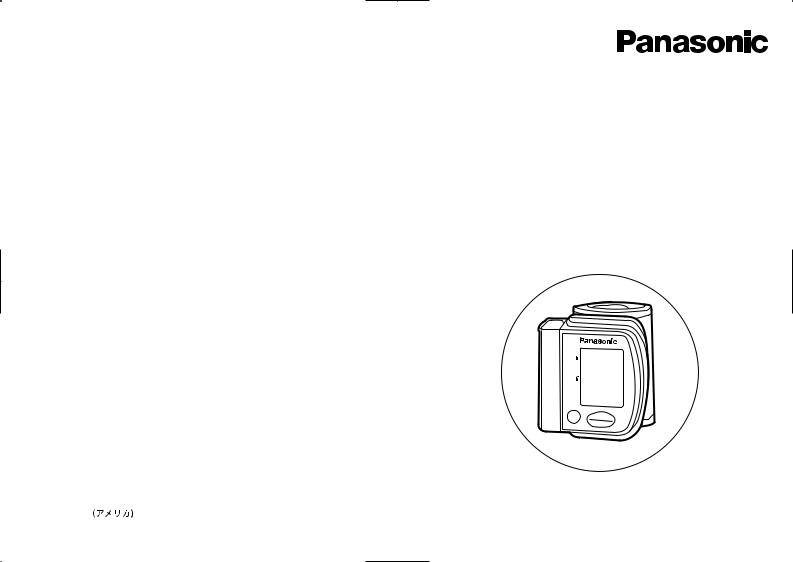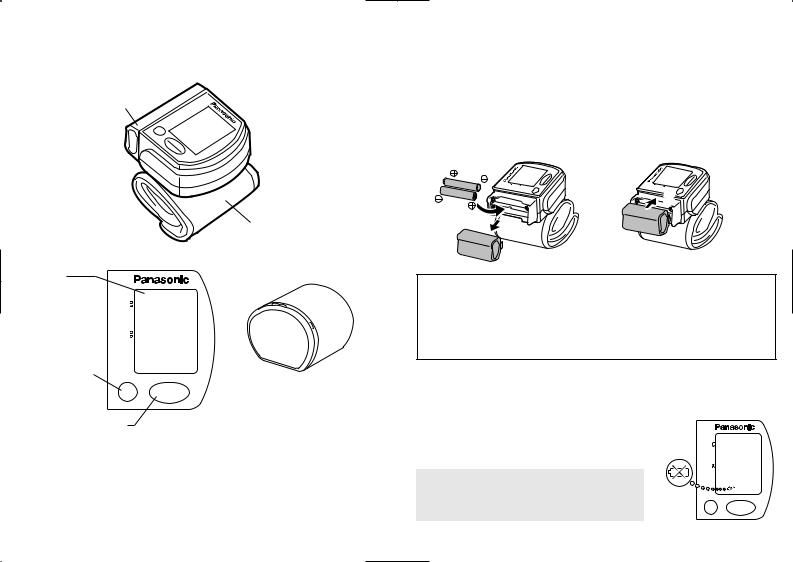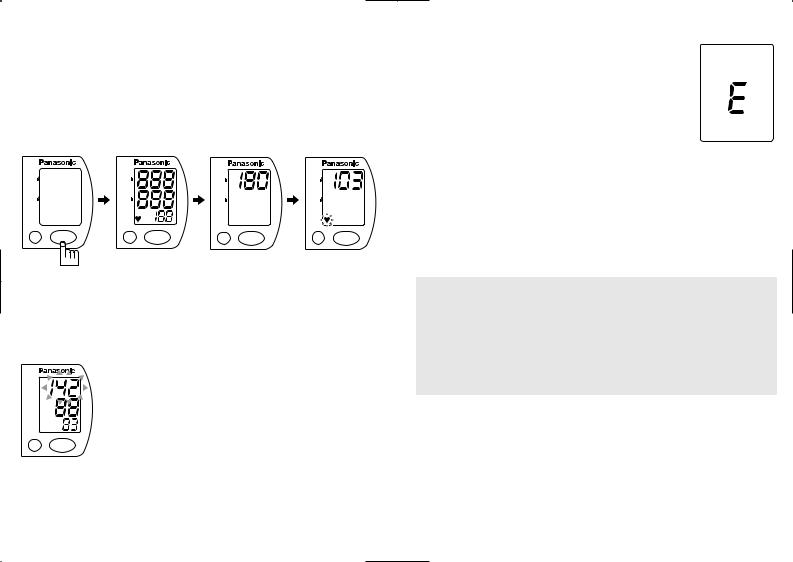Panasonic EW3002 User Manual

For questions or assistance with your blood pressure
monitor, call us at 1-800-338-0552.
Panasonic Consumer Electronics Company
A Unit of Matsushita Electric Corporation
of America
One Panasonic Way 3D-1
Secaucus, NJ 07094
No.1 EN,SP |
|
© 2002 Matsushita Electric Works, Ltd. All Rights Reserved. |
Printed in China |
Wrist Blood Pressure Monitor
Monitor de presión arterial de colocación en la muñeca
Operating Instructions
Instrucciones de funcionamiento
Model No. EW3002
Modelo No. EW3002
LOGIC™ |
DIA. |
|
|
SYS. |
|
|
mmHg |
|
PRECISE |
mmHg |
|
P/min. |
|
|
|
|
|
|
R |
On/Off |
|
|
Start |
Before operating this device, please read these instructions completely and save this manual for future use.
Antes de usar este dispositivo, lea completamente estas instrucciones y guarde este manual para utilizarlo como referencia en el futuro.

Thank you for purchasing the Panasonic Wrist Blood Pressure Monitor EW3002. Designed for easy, one-touch operation, this monitor incorporates Precise Logic™ technology to provide accurate, reliable measurements. It comes with a handy carrying case that also serves as an armrest during measurement.
Measuring your own blood pressure is an important way of monitoring your health. High blood pressure (hypertension) is a major health problem which can be treated effectively once detected. Measuring your blood pressure between doctor visits on a regular basis in the comfort of your home, and keeping a record of the measurements, will help you monitor any significant changes in your blood pressure. Keeping an accurate record of your blood pressure will help your doctor diagnose and possibly prevent any health problems in the future.
Table of Contents
Basics of Blood Pressure • • • • • • • • • • • • • • • • • • • • • • • • • • • • • • • • • • • • • • • • • • • • • • • • • • • • • • • 3 Important Instructions Before Use • • • • • • • • • • • • • • • • • • • • • • • • • • • • • • • • • • • • • • • • • • • • • • 4
Precautions to Ensure Safe, Reliable Operation • • • • • • • • • • • • • • • • • • • • • • • • • • • • • • 6
Name and Function of Each Product Part • • • • • • • • • • • • • • • • • • • • • • • • • • • • • • • • • • • • • 7 Inserting/Replacing Batteries • • • • • • • • • • • • • • • • • • • • • • • • • • • • • • • • • • • • • • • • • • • • • • • • • • • 8 When to Change Batteries • • • • • • • • • • • • • • • • • • • • • • • • • • • • • • • • • • • • • • • • • • • • • • • • • • • • • 8 Positioning the Pressure Cuff • • • • • • • • • • • • • • • • • • • • • • • • • • • • • • • • • • • • • • • • • • • • • • • • • • 9
Correct Position for Blood Pressure Measurement • • • • • • • • • • • • • • • • • • • • • • • • • • • • 9
Taking measurements while sitting down • • • • • • • • • • • • • • • • • • • • • • • • • • • • • • • • • • • • • • 9 Taking measurements while lying down • • • • • • • • • • • • • • • • • • • • • • • • • • • • • • • • • • • • • • 10 Measuring Your Blood Pressure • • • • • • • • • • • • • • • • • • • • • • • • • • • • • • • • • • • • • • • • • • • • • • 11 World Health Organization Guidelines • • • • • • • • • • • • • • • • • • • • • • • • • • • • • • • • • • • • • • • • 13 Recalling Stored Data • • • • • • • • • • • • • • • • • • • • • • • • • • • • • • • • • • • • • • • • • • • • • • • • • • • • • • • • • 14 Deleting Data • • • • • • • • • • • • • • • • • • • • • • • • • • • • • • • • • • • • • • • • • • • • • • • • • • • • • • • • • • • • • • • • • • 14
About the Precise Logic™ Measurement System • • • • • • • • • • • • • • • • • • • • • • • • • • • • 15
Care and Maintenance • • • • • • • • • • • • • • • • • • • • • • • • • • • • • • • • • • • • • • • • • • • • • • • • • • • • • • • • 16 Storing the Monitor • • • • • • • • • • • • • • • • • • • • • • • • • • • • • • • • • • • • • • • • • • • • • • • • • • • • • • • • • • • • 16 Troubleshooting • • • • • • • • • • • • • • • • • • • • • • • • • • • • • • • • • • • • • • • • • • • • • • • • • • • • • • • • • • • • • • • 17 Specifications • • • • • • • • • • • • • • • • • • • • • • • • • • • • • • • • • • • • • • • • • • • • • • • • • • • • • • • • • • • • • • • • • • 19
1 |
2 |

Basics of Blood Pressure
Your heart acts like a pump, sending blood surging through your blood vessels each time it contracts. Blood pressure is the pressure exerted by blood pumped from the heart on the walls of blood vessels. Systolic pressure is the pressure exerted when the heart contracts and pumps blood into the arteries. Diastolic pressure is the pressure exerted when the heart expands, or relaxes. When you or your doctor take your blood pressure, both your systolic and diastolic pressures are measured. If your blood pressure measurement is 120 over 80 (120/80), for example, your systolic pressure is 120 while your diastolic pressure is 80.
Important Instructions Before Use
1.Do not confuse self-monitoring with self-diagnosis. Blood pressure measurements should only be interpreted by a health professional who is familiar with your medical history.
2.If you are taking medication, consult with your physician to determine the most appropriate time to measure your blood pressure. NEVER change a prescribed medication without first consulting with your physician.
3.For persons with irregular or unstable circulation resulting from diabetes, liver disease, arteriosclerosis or other medical conditions, there may be variations in blood pressure values measured at the wrist versus at the upper arm. Monitoring the trends in your blood pressure taken at either the arm or the wrist is nevertheless useful and important.
4.Blood pressure can vary based on many factors, including age, gender, weight and physical condition. In general, a person’s blood pressure is lower during sleep and higher when he or she is active. Blood pressure can change easily in response to physiological changes. The setting in which a person’s blood pressure is measured can also affect the results. Having one’s blood pressure measured by a healthcare professional in a hospital or clinic can cause nervousness and may result in a temporarily elevated reading. Because blood pressure measurements taken in a clinical setting can vary considerably from those taken at home, a person’s blood pressure should be measured not only occasionally in the doctor’s office, but also on a regular basis at home. Also, if you find that your blood pressure is lower at home, this is not unusual. To accurately compare with your physician’s reading, take your Panasonic blood pressure monitor to your doctor’s office and compare readings in this setting.
5.People suffering from cardiac arrhythmia, vascular constriction, liver disorders or diabetes, people with cardiac pacemakers or a weak pulse, and women who are pregnant should consult their physician before measuring their blood pressure themselves. Different values may be obtained due to their condition.
3 |
4 |

6.Try to take your blood pressure measurements at the same time and under the same conditions every day.
•The ideal time to measure your blood pressure (to obtain your socalled “base blood pressure”) is in the morning just after waking up, before having breakfast and before any major activity or exercise. If this is not possible, however, try to take measurements at a specified time prior to breakfast, and before you have become active. You should relax for about 5 minutes before taking the measurement.
•The following situations may cause substantial variations in blood pressure readings and should therefore be avoided at least 30 minutes prior to taking your blood pressure.
Blood pressure will be higher than usual:
–when you are excited or tense
–when you are taking a bath
–during exercising or soon after exercising
–when it is cold
–within one hour after eating
–after drinking coffee, tea or other beverages containing caffeine
–after smoking tobacco
–when your bladder is full
Blood pressure will be lower than usual:
–after taking a bath
–after drinking alcohol
7.Measurements may be impaired if this device is used near a television, microwave oven, X-ray equipment or other devices with strong electrical fields. To prevent such interference, use the monitor at a sufficient distance from such devices or turn the devices off.
8.This device is designed for use by adults. Consult with your physician before using this device on a child. Do not use on infants or toddlers.
9.This device is not suitable for continuous monitoring during medical emergencies or operations.
10.Do not use the unit for any purpose other than measuring blood pressure. Also, do not use the unit in combination with any other equipment.
11.Improper handling of batteries may result in battery rupture or in corrosion from battery leakage. Please observe the following to ensure proper use of batteries.
a.Be sure to turn off the power of the device after use.
b.Do not mix different types or sizes of batteries.
c.Change all batteries at the same time. Do not mix old and new batteries.
d.Be sure to insert batteries with correct polarity, as instructed.
e.Remove batteries when they are worn out, and dispose of them properly according to all applicable environmental regulations.
f.Do not disassemble batteries or throw them into a fire.
g.Do not short-circuit batteries.
h.Do not charge the batteries included with this unit.
Precautions to Ensure Safe, Reliable Operation
1.Do not drop the device. Protect it from sudden jars or shocks.
2.Do not insert foreign objects into any openings.
3.Do not attempt to disassemble the unit.
4.Do not crush the pressure cuff.
5.If the unit has been stored at temperatures below 0°C (32°F), leave it in a warm place for about 15 minutes before using it. Otherwise, the cuff may not inflate properly.
6.Do not store the unit in direct sunlight, high humidity or dust.
5 |
6 |

Name and Function of Each Product Part
Fig. 1
Battery cover
|
|
m |
S |
|
|
|
|
Y |
|
|
|
m |
S. |
|
m |
D |
|
Hg |
|
m IA. |
|
|
||
P/ |
Hg |
|
|
|
|
|
|
|
|
m |
|
|
|
|
in. |
|
|
|
|
R |
|
|
|
|
StartOn/Off |
|
|
|
|
|
|
Pressure cuff |
Display |
|
|
SYS. |
|
|
mmH |
|
|
DIA. |
|
|
mmH |
|
|
P/min. |
|
|
Recall button |
|
|
R |
On/Off |
Hard carrying case |
|
Start |
(Can be used as an armrest) |
Start (On/Off) button |
|
|
Inserting/Replacing Batteries
1.Grasp the battery cover and remove it to the left as shown in Fig. 2-a.
2.Insert two 1.5 V alkaline (AAA/LR03) batteries, observing the (+) and (-) signs to ensure correct polarity.
3.Close the battery cover until it clicks into place (Fig. 2-b).
•Approximately 500 measurements can be taken with a new set of Panasonic alkaline batteries (at an ambient temperature of 22°C (71.6°F), pressurization of 180 mmH ).
).
Fig. 2-a Fig. 2-b
2 |
|
|
|
|
|
|
|
|
On/OffStart |
|
|
|
|
|
|
|
|
|
On/OffStart |
|
YS |
.mHg |
IA |
. |
Hg |
|
in |
. |
|
S |
YS. |
Hg |
. |
H |
g |
|
|||
|
S m |
|
m |
|
P/m |
R |
|
|
m |
m |
I |
A |
|
P/min |
. |
||||
|
|
|
D m |
|
|
|
|
|
|
|
D |
mm |
|
|
R |
||||
|
|
|
|
|
|
|
|
|
|
™ |
|
|
|
|
|
|
|
3 |
|
|
|
|
|
|
|
|
|
|
|
LOGIC |
PRECISE |
|
|
|
|
|
|||
|
|
|
|
|
|
|
|
|
|
|
|
|
|
|
|
||||
™ICGOL |
1 |
|
|
|
|
|
|
|
|
|
|
|
|
|
|
|
|
|
|
|
EIS |
|
|
|
|
|
|
|
|
|
|
|
|
|
|
|
|
|
|
|
CERP |
|
|
|
|
|
|
|
|
|
|
|
|
|
|
|
|
|
|
Notes:
•Do not mix old and new batteries.
•The batteries’ power output is impaired at low temperatures.
•The performance of the batteries included with the product may be affected somewhat according to factors such as the amount of time past
since the date of manufacture.
When to Change Batteries
Change the batteries when the battery symbol |
Fig. 3 |
|
|
(Fig. 3) appears on the display or when no data |
|
is displayed even when the On/Off button is |
|
pressed. |
|
CAUTION: |
|
Do not throw batteries into a fire. Doing so |
|
may result in an accident or explosion. |
|
SYS. mmH
DIA. mmH
P/min.
ROn/Off Start
7 |
8 |

Positioning the Pressure Cuff
CAUTIONS:
•Do not use the unit for any purpose other than measuring blood pressure. Also, do not use the unit in conjunction with other devices. Improper use may cause a malfunction or personal injury.
•Keep the unit out of the reach of children.
1. |
Remove your watch and any jewelry from |
Fig. 4 |
|
your left hand. |
|
2. |
Place the monitor on the palm side of your |
|
|
wrist, roughly 1.5 cm (1/2") below your |
|
|
palm as shown in Fig. 4, and secure it with |
|
|
the hook-and-loop tape so that it fits |
|
|
comfortably (is neither too tight nor too |
|
|
loose). |
|
3. |
Make sure that the display is on the inside |
1.5 cm (1/2") |
|
of your wrist (palm side up). Also, center |
|
the unit on your wrist.
Correct Position for Blood Pressure Measurement
When measuring your blood pressure at your wrist, the pressure cuff must be at heart level to ensure consistent, accurate readings.
Taking measurements while sitting down
1.Place your elbow on a table.
2.Using the hard carrying case or other object as a support, position your wrist at heart level.
•Your blood pressure measurement will be too low if you hold your hand too high, or too high if you hold your hand too low.
3. Open and relax your hand with the palm |
Fig. 5 |
|
facing up. Closing your hand will cause |
||
|
||
inaccurate readings. |
|
|
• Do not bend your wrist inward. Bending |
|
|
your wrist will cause inaccurate readings. |
|
4.Empty bladder, if possible, before taking blood pressure.
Taking measurements while lying down
1.Lie on your back.
2.Rest your wrist on a support or cushion with the palm side facing up; position your wrist at heart level.
3.Open and relax your hand with the palm facing up. Closing your hand will cause inaccurate readings.
•Do not bend your wrist inward. Bending your wrist will cause inaccurate readings.
Fig. 6
4. Empty bladder, if possible, before taking blood pressure.
IMPORTANT:
•Measure your blood pressure at the same time and under the same conditions every day if possible. The ideal time to measure your blood pressure is in the morning immediately after waking up, while you are still relatively calm. If this is not possible, try to take your blood pressure prior to breakfast, before you become active.
•Relax and take measurements in a comfortable position.
•Rest for at least 5 minutes before taking a measurement.
•Keep still and do not speak during measurement. Blood pressure can fluctuate with the slightest change, such as tensing your muscles or changing your posture.
9 |
10 |

Measuring Your Blood Pressure
Relax during measurements.
1.To begin measurement, press the Start (On/Off) button (Fig. 7).
•The LCD display will show 888 and then switch to 0. The pressure cuff will automatically inflate (Fig. 8).
•The pressure gradually decreases and when the pulse is detected, the heart mark will blink (Fig. 10).
Fig. 7 |
|
Fig. 8 |
|
Fig. 9 |
|
Fig. 10 |
|
SYS. |
|
SYS. |
|
SYS. |
|
SYS. |
|
mmH |
|
mmH |
|
mmH |
|
mmH |
|
DIA. |
|
DIA. |
|
DIA. |
|
DIA. |
|
mmH |
|
mmH |
|
mmH |
|
mmH |
|
P/min. |
|
P/min. |
|
P/min. |
|
P/min. |
|
R |
On/Off |
R |
On/Off |
R |
On/Off |
R |
On/Off |
Start |
Start |
Start |
Start |
2.When finished, the blood pressure measurement and the pulse rate (number of beats per minute) are indicated on the display. The air in the pressure cuff is then automatically released. If the measured values fall within the hypertension range, the displayed values will blink for about 6 seconds (Fig. 11).
Fig. 11
SYS. mmH
DIA. mmH
P/min.
ROn/Off Start
Error
• If “E” (meaning error) appears in the display (Fig.12) Fig. 12 during measurement, an error has occurred, e.g., you
have moved your hand during measurement. In this case, turn the unit off, wait at least 5 minutes and measure again.
3. A measurement is automatically stored in the memory.
• Up to 21 measurements can be stored and recalled later. After you have stored 21 measurements, the oldest one will be deleted automatically when you measure a new one.
4.To switch the unit off, press the Start (On/Off) button.
•The unit switches off automatically approximately 5 minutes after measurement is completed.
Note:
•During the measurement, the unit may re-inflate once or twice in order to start at the appropriate pressure level. This is normal and is not an indication of a malfunction.
CAUTION:
•For persons with poor circulation resulting from diabetes, liver disease, arteriosclerosis, high blood pressure or other conditions, there may be significant differences in blood pressure values measured at the wrist versus at the upper arm.
•Do not confuse self-monitoring with self-diagnosis.
•NEVER change a prescribed medication without first consulting with your physician.
11 |
12 |
